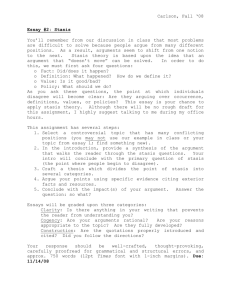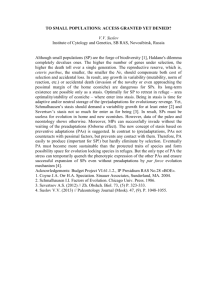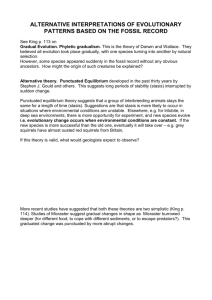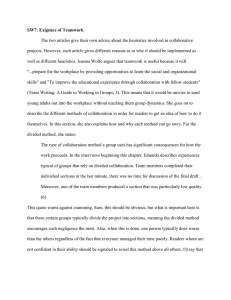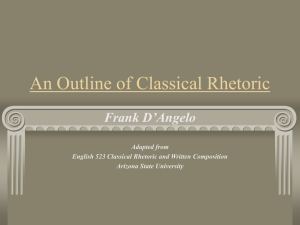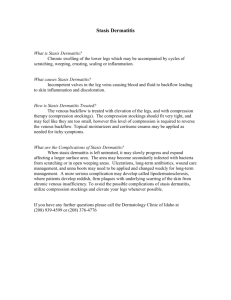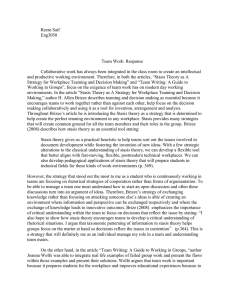Chapter Seven: The stasis system.
advertisement
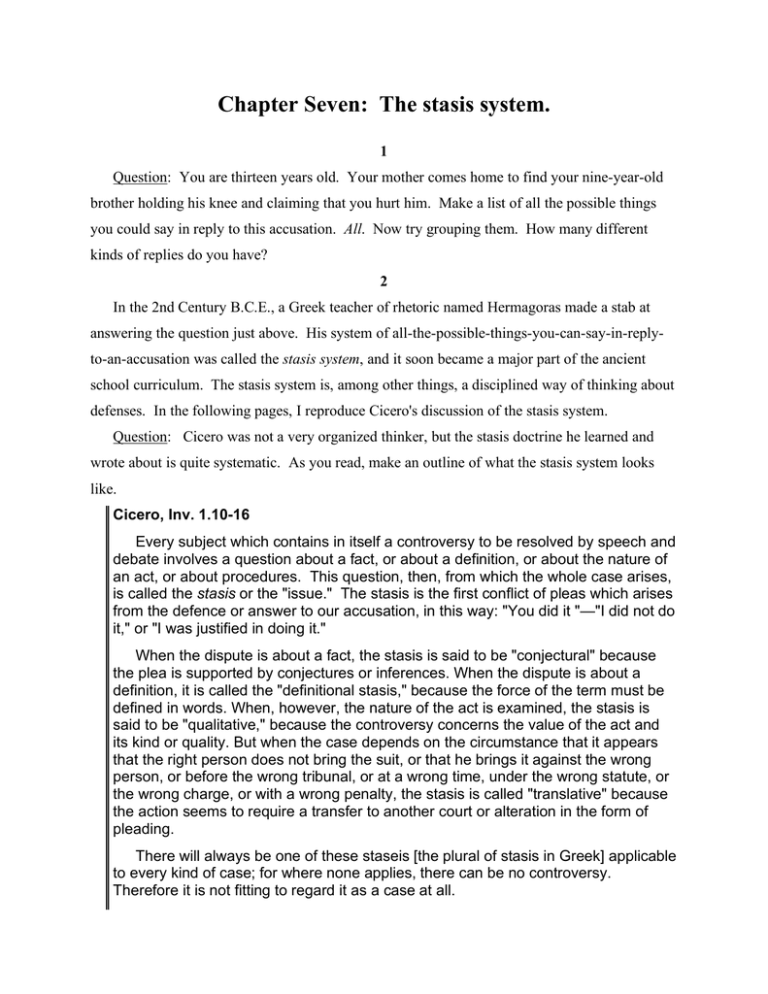
Chapter Seven: The stasis system. 1 Question: You are thirteen years old. Your mother comes home to find your nine-year-old brother holding his knee and claiming that you hurt him. Make a list of all the possible things you could say in reply to this accusation. All. Now try grouping them. How many different kinds of replies do you have? 2 In the 2nd Century B.C.E., a Greek teacher of rhetoric named Hermagoras made a stab at answering the question just above. His system of all-the-possible-things-you-can-say-in-replyto-an-accusation was called the stasis system, and it soon became a major part of the ancient school curriculum. The stasis system is, among other things, a disciplined way of thinking about defenses. In the following pages, I reproduce Cicero's discussion of the stasis system. Question: Cicero was not a very organized thinker, but the stasis doctrine he learned and wrote about is quite systematic. As you read, make an outline of what the stasis system looks like. Cicero, Inv. 1.10-16 Every subject which contains in itself a controversy to be resolved by speech and debate involves a question about a fact, or about a definition, or about the nature of an act, or about procedures. This question, then, from which the whole case arises, is called the stasis or the "issue." The stasis is the first conflict of pleas which arises from the defence or answer to our accusation, in this way: "You did it "—"I did not do it," or "I was justified in doing it." When the dispute is about a fact, the stasis is said to be "conjectural" because the plea is supported by conjectures or inferences. When the dispute is about a definition, it is called the "definitional stasis," because the force of the term must be defined in words. When, however, the nature of the act is examined, the stasis is said to be "qualitative," because the controversy concerns the value of the act and its kind or quality. But when the case depends on the circumstance that it appears that the right person does not bring the suit, or that he brings it against the wrong person, or before the wrong tribunal, or at a wrong time, under the wrong statute, or the wrong charge, or with a wrong penalty, the stasis is called "translative" because the action seems to require a transfer to another court or alteration in the form of pleading. There will always be one of these staseis [the plural of stasis in Greek] applicable to every kind of case; for where none applies, there can be no controversy. Therefore it is not fitting to regard it as a case at all. Chapter Seven, p. 2 [In a controversy about the issue of fact or "conjectural stasis" the question is straightforward: did the accused do it? For example—did Orestes kill Clytemnestra?] The controversy about a definition arises when there is agreement as to the fact and the question is by what word that which has been done is to be described. In this case there must be a dispute about the definition, because there is no agreement about the essential point, not because the fact is not certain, but because the deed appears differently to different people, and for that reason different people describe it in different terms. Therefore in cases of this kind the matter must be defined in words and briefly described. For example: if a sacred article is purloined from a private house, is the act to be adjudged "theft" or "sacrilege"? For when this question is asked, it will be necessary to define both theft and sacrilege and to show by one's own description that the act in dispute should be called by a different name from that used by the opponents. There is a controversy about the nature or character of an act when there is both agreement as to what has been done and certainty as to how the act should be defined, but there is a question nevertheless about how important it is or of what kind, or in general about its quality, e.g. was it just or unjust, profitable or unprofitable? It includes all such cases in which there is a question about the quality of an act without any controversy about definition. . . . In the fourth stasis which we call the translative there is a controversy when the question arises as to who ought to bring the action or against whom, what law or at what time, and in general when there is some argument about changing or invalidating the form of procedure. Hermagoras is thought to be the inventor of this stasis, not that orators did not use it before his day--many did use it frequently-but because earlier writers of textbooks did not notice it or include it with the issues. Since his invention of the term many have found fault with it, not misled by ignorance, I think, for the case is perfectly plain, so much as they have been kept from adopting it by a spirit of envy and a desire to disparage a rival [professor of rhetoric]. We have explained the staseis and their subdivisions, but it would seem that we can give instances of each kind more conveniently when we give a store of arguments for each of them, for the principles of argumentation will be plainer if they can be applied immediately both to the general classification and to the particular instance. [Which we will do in later chapters]. This is rather complex. It may help to make clear what the stasis system is supposed to do. 1. Primarily, the stasis system defines all the possible kinds of forensic cases. Every case has at least one central issue in dispute—if not, as Cicero points out, there is no controversy, no dispute, nothing to argue about, no case. As it turns out, there are not an infinite number of possible kinds of cases. According to Cicero, in fact, there are only four: "conjectural," definitional, qualitative and "translative." Chapter Seven, p. 3 2. The stasis system also shows how this central issue is formed. An accusation is made: "You hurt me!"—and then defender can respond, according to Cicero: "No I didn't!" [conjectural] "Yes, I did do those physical motions, but I didn't do that precise action you say I did!" [definition] "Yes, I did what you say, but it was justified or excusable!" [qualitative] "You have no right to say that!" [translative] The stasis—the central issue—arises "from the first conflict," when the accusation hits up against the defense. You might picture it like this: A----------> <-----------D | | v stasis The Greek word "stasis" has its roots in a word meaning "to stand in place;" it also means "whirlwind." The image here may be of two powerful winds blowing in opposite directions— the accusation and the defense—hitting each other to create a violent whirlwind—i.e. a dispute— which stands in place. 3. Accusations are all alike, plain vanilla. A case gets its flavor not from the accusation but from the defense. The stasis system which defines all the different types of cases therefore also defines all the different defenses: all the things that the defender can say back to the accuser. 4. And finally, the stasis system helps the defender think through his choices, and the accuser think through the choices the defender will make. The stasis system is arranged by a sort of process of elimination. If you are accused, you might first think of just denying that you did it. But if you can't deny it, you might still abe able to squabble about the definition of what you did. If this won't work, you can claim that what you did was not wrong (for some reason). And if you're really stuck, then you can argue that there are procedural problems with the accusation. So the stasis system also represents the defender's (and the accuser's) thought processes as they prepare their cases. Question: Does Cicero's stasis system really include all possible defenses? Check back with the "stasis system" you invented in Section 1. What did you think of that Cicero missed? Chapter Seven, p. 4 3 The stasis system outlined by Cicero in the previous section seemed a little messy. So I am here going to keep the basic idea, but to re-order Cicero's version a bit, use clearer names and divide Cicero's one big "qualitative" stasis into several different parts, all in order to render the system more accurate and useful. The accuser says "You hurt me!" What can the defender say back? 1. "How dare you speak to me in that way! It's none of your business!"—Refusal (i.e. refusal to make any answer to the accusation). 2. "I didn't do it!"—Denial. The defender answers, but asserts that what the accuser said is false: the defender did not hurt the accuser. 3. "I did what you say, but that is not against the law!"–Statutory Interpretation. The defender admits having done something, but asserts that it does not meet the criteria of what the law makes wrongful. 4. "I did it, and I was right to!"—Justification. The defender admits having done something, but asserts that it was the right thing to do. 5 "I did it, and I know it wasn't right, but I didn't really mean it."—Excuse. The defender admits the act, and admits that it was unjustified, but argues that he should not be blamed for it. 6. "I did it, it was wrong, I apologize."—Apology. The defender admits everything and begs for forgiveness. Notice how each of these builds on the previous: it is as if when the defender can't say one, she is driven to say the next. Question: What are the strategic advantages and disadvantages of each stasis for the defender? which is the strongest? Question: What is the stasis of the Simpson murder case? What were other possibilities? Question: What is the stasis of the impeachment of President Clinton? What were the other possibilities? Refusals to answer are perhaps the most common form of response to an accusation. Why? Answering charges is often a waste of time. Taking that time, furthermore, suggests that the accuser deserves the respect shown in answering, which is not always the case—as we say, "I will not dignify that with an answer." So many serious accusations, especially in politics and international affairs, often get conspicuously ignored by the person defender. Apologies are also quite common. But neither of these two defenses lead to legal arguments, although they may lead to other kinds of talk. (It often requires some strategy and elegance to apologize Chapter Seven, p. 5 persuasively without demeaning oneself utterly--you can probably come up with an example of an ineffective apology). Therefore, we're going to leave out Refusal and Apology, and in the following chapters covering only half of the staseis: Denial, Justification and Excuse; one each in each of the following chapters 4 The stasis system has at least one further use: it helps each side refine their trial strategies. The process of going back and forth between accuser and defender does not stop after the first round that formed the stasis. It continues for a second exchange, forming what you've learned to call the theory of the case. Cicero's discussion of this is somewhat obscure; in the following, I will more re-do his work than translate it. We saw in the previous section how the collision of accusation and defense creates a stasis, the general issue presented by a case. But each side has much more to say than just "you did it" and "I was justified" (or whatever). Notice that the stasis is not very specific or detailed or determinate. It would be the same, for example, in the cases both of Jeffrey Dahmer and the Menendez brothers—"was what they did really wrong, or can they be excused?" To ensure that there really is a dispute, each side has to do more than merely assert guilt or innocence. Each side has to put forward the basic reason or reasons for her assertion. Cicero calls this the "foundation" or "rationale" of the case. Following modern authors, we call it the "theory." Each side's theory is where the general and rather vague stasis is filled in with the details of this particular case—or at least, the details as seen by that side. It is also the ultimate conclusion that each side will attempt to prove throughout it's case. Cicero gives the following example. Orestes is accused of murdering his mother. Orestes defends himself, saying that he was justified in doing it. This forms the stasis: Justification. But there still isn't anything here to debate. Orestes must go on: "I'm justified, because my mother killed my father." To which the accuser replies: "But your mother ought not to have been killed by you, her son; her act could have been punished without your committing a crime." These more detailed assertions constitute the theories of the case for each side. In Cicero's words, they "narrow" or "limit" the case, focusing it on one key point for decision: "was it right for Orestes to kill his mother because she had killed his father?" So we have a new picture of the development of a case that looks something as follows: Chapter Seven, p. 6 A --------> <-------- D | | v stasis | | v A-theory --------> <-------- D-theory | | v point for decision In almost all cases, there will be more than one theory available to both the accuser and the defender. The Simpson case clearly demonstrates this point. The accuser could have argued-and did argue at various points--any of the following theories: a1: A massive amount of physical evidence clearly shows that Simpson is guilty. a2: Simpson, a longtime wife beater, was finally driven over the edge by jealously and brutally murdered his ex-wife. The defender, on the other hand, could argue these theories: d1: Given the mishandling of evidence by incompetent police, there is reasonable doubt that Simpson did it. d2: A drug dealer did it. d3: The prosecutors, rushing to get a conviction, are in league with a corrupt and racist police force in framing Simpson for the murder. And these are only some of the possibilities. Choosing your theory of the case will be the most important strategic decision you make. Your theory will guide your research—you will be looking for facts which support it. Your theory will also guide your arguments, all of which must be directed to proving your theory. If you fail to prove your theory, you lose. Because it is so important, however, you do not actually commit to a theory until you start presenting your case for a decision. You refine your theory as you discover more facts through research. You also refine it as you figure out what your opponent is going to say, since some theories are more powerful in opposition to specific theories of the other side. In the Simpson case, for example, a1 is best answered by d1 or d3, while d2 seems to be a stronger reply to a2. Think about it. Chapter Seven, p. 7 5 One final point. Cicero says: "When the issue in the case has been determined, it is well to consider whether the case is simple or complex. A simple case is one which contains in itself one plain question. A complex case is made up of several questions." A complex case, in other words, is one in which more than one defense theory is being pursued. Sometimes this presents no problem: for example, an alibi ("I wasn't there!") can easily be combined with a shifting of the blame ("It was really X that did it.") Sometimes, however, the multiple defenses can be a source of stress. Nowadays, we often think of "complex" cases as involving "even-if" arguments. For example: "I didn't do it—but even if I did, I was insane at the time." "Even-if" arguments are a litmus test distinguishing lawyers from ordinary folk. Lawyers are able to hold the two (or more) aspects of the case in separate sections of their mind. The arguments for each defense can be weighed and considered independently of their effect on other defenses. Ordinary people may not view it this way. They tend to hear a complex defense as selfcontradictory. The defender is clearly lying at least once when she makes an "even-if" defense; this would seem to be good grounds for rejecting both (or all) of her defenses. This ordinary attitude has been around for a long time. Consider the following anecdote of legal mischief from the early nineteenth century. From a Memoir of Massachusetts Chief Justice Theophilus Parsons A plaintiff brings an action against a neighbor for borrowing and breaking the iron pot in which he cooked his dinner. The defendant says he never borrowed any pot; and that he used it carefully; also, that the pot was broken and useless when he borrowed it; also, that he borrowed the pot of somebody not the plaintiff; also, that the pot in question was the defendant's own pot; also that the plaintiff never owned any pot, iron or other; also that the defendant never had any pot whatever. Question: Assume that you have a case with several possible defenses—perhaps an alibi ("I wasn't there!"), a straight denial ("I was there, but I didn't do it!"), and an excuse ("OK, I did it, but it was an accident!"). What are the strategic advantages and disadvantages of raising all the defenses at the same time? What are the strategic advantages and disadvantages of picking just one?
